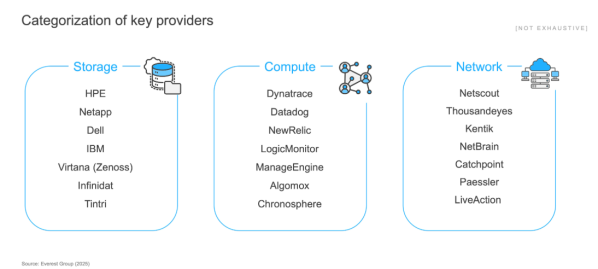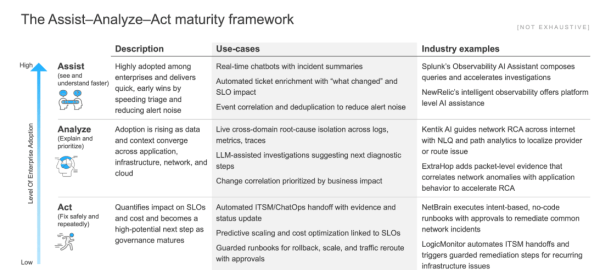Blog
AI-powered observability: The next frontier in modern operations

Enterprises today are generating more telemetry than ever, often analyzing over a trillion metrics a day across millions of devices. Yet, despite this data abundance, less than 25% of the enterprises report full-stack observability, and most of them struggle to stitch together insights across five or more disconnected tools.
Traditional monitoring, built for static infrastructure and predictable workloads, simply cannot keep pace with the complexity of modern, distributed systems. Teams are overwhelmed by alert storms, false positives, and siloed dashboards that make triage slow and inconsistent. As cloud, microservices, edge, and Software as a Service (SaaS) ecosystems expand, operational noise multiplies faster than human capacity to interpret it.
The outcome is familiar: extended Mean Time To Repair (MTTR), finger-pointing across teams, and ballooning costs from redundant tools. Manual triage and rule-based correlation, once adequate, now collapse under scale. Enterprises now need not just visibility, but intelligence that connects symptoms to causes, predicts risks, and recommends governed actions in real time.
Reach out to discuss this topic in depth.
How AI-powered observability bridges the gap:
Artificial Intelligence (AI)-powered observability directly addresses this breakdown by applying advanced analytics, machine learning, and agentic AI to unify telemetry across applications, infrastructure, networks, and cloud. Rather than relying on static thresholds or manual triage, these AI-powered observability platforms use topology-aware causal reasoning to correlate millions of events into actionable insights. This transforms observability from a data-collection function into a diagnostic and preventive discipline.
The shift is not only technological; it is equally architectural and operational. Built on governed autonomy, AI-powered observability enables systems to explain not only what failed, but why and what to do next, grounding recommendations in live topology, Service Level Objectives (SLOs), and change data.
A market reset on observability:
There is a broader shift on both the demand and supply sides. On the buyer side, expectations have moved beyond “visibility only” towards a convergence of observability, security, and FinOps that governs both risk and spend. Natural Language (NL) assistants/ chatbots and agentic workflows are now table stakes, but only when grounded in unified telemetry, live topology, and SLOs. Approximately one in four enterprises already apply AI and generative AI (gen AI) to Artificial Intelligence for IT Operations (AIOps) to enhance monitoring, analytics, and automation, and they increasingly expect answers that explain business impact (e.g., which journey is at risk?) and propose next steps with guardrails and auditability.
Providers are increasingly pivoting from products to platforms and System Integration (SI)-led integration layers that enable cross-tool automation. Vendors are converging on unified data planes and live service maps so that AI can deliver precise, real-time answers and safe actions. The result is a move from reactive monitoring to proactive prevention and cost governance. Enterprises are consolidating tools, strengthening automation guardrails, and realizing measurable gains in MTTR, alert noise, SLO attainment, and total cost to observe.
Key players and signals:
A few providers in the market are already aligning with the buyer demand signals. We have categorized key providers and signals across three layers of the observability ecosystem- Storage (data), Compute (application and infrastructure observability), and Network. The table below highlights both end-to-end observability platforms and niche innovators advancing AI and agentic operations in observability.
[Not exhaustive]

Together, these providers illustrate how the market is converging on unified data planes and agentic automation as differentiators.
Enterprise adoption:
Most discussions on AI-powered observability today focus narrowly on chatbots and Natural Language Query (NLQ) assistants. These interfaces help engineers query telemetry, summarize incidents, and reduce alert noise. They are useful, highly visible, and relatively easy to scale, which explains why more than 52% of enterprises report chatbot deployments and often equate them with AI-driven observability.
However, this represents only the surface layer of what AI can enable. Chatbots improve accessibility to data, but they do not fundamentally change how systems detect, explain, or resolve issues. The real value lies beneath, in AI’s ability to correlate events across domains, infer causality, and trigger governed actions that enhance reliability and cost predictability. Chatbots are the on-ramp, not the destination.
To understand what lies beyond this surface layer, it helps to trace how enterprise capabilities mature, from assistive visibility to governed, intelligent action.
The Assist–Analyze–Act maturity framework:
As enterprises expand beyond early chatbot use, AI-powered observability typically evolves through three stages, Assist, Analyze, and Act; each representing deeper integration of AI into operational decision-making. The sequence offers a pragmatic adoption roadmap: implement quick wins now, pilot next-stage analytics as context strengthens, and scale governed automation as trust and control mature.

Implications for enterprises:
As AI-driven operations move from pilots to production, nearly 74% of enterprises plan to increase spending on AI or gen AI by more than 10% over the next two years. Early traction is strongest in digital-first, high-change sectors such as financial services and e-commerce, where customer-experience SLOs and internet-path dependencies raise the bar for reliability. To capture this momentum, enterprises should pivot to the following priorities:
- Adopt an SLO-first, unified telemetry fabric. Integrate metrics, logs, traces, topology, and change data so AI can deliver precise, explainable answers and actions. This directly lowers MTTR and error-budget minutes while improving customer-experience reliability
- Build an observability data lakehouse. Establish a scalable data lake with a knowledge graph that captures service relationships, ownership, performance, and context. This creates consistent semantics across tools and accelerates Root Cause Analysis (RCA) and impact analysis
- Govern automation for safe, cost-aware action. Enforce approvals, audit trails, and blast-radius limits around agentic runbooks (rollback, scale, reroute). Strong governance reduces operational risk and aligns observability with FinOps objectives
- Advance core observability analytics. Strengthen event aggregation, intelligent tagging, and anomaly detection to cut noise and surface early-risk signals. Smart correlation reduces duplicate alerts, sharpens prioritization, and speeds triage without re-plumbing workflows
- Rewire operating models to amplify scarce talent. Use NLQ assistants, guided investigations, and standardized runbooks to broaden who can triage and remediate issues. This accelerates releases with less risk and produces clearer, defensible Return on Investment (ROI)
Enterprises that embrace observability as a data-to-decision system rather than a monitoring function will lead the next wave of operational excellence. AI-powered observability is no longer a niche capability; it is becoming the foundation for digital reliability, cost predictability, and AI-ready operations. Providers who build this intelligence layer today will be the first to achieve self-healing systems, measurable SLO assurance, and sustainable speed at scale.
If you find this blog interesting, check out our report, Innovation Watch: AI-powered Observability – Everest Group Research Portal.
If you have any questions, would like to gain expertise in observability, or would like to reach out to discuss these topics in more depth, contact Lalith Kumar ([email protected]), Titus M ([email protected]), Asritha Gantla ([email protected]), Nithya S ([email protected]) or Shreyas Rastogi ([email protected]).